Berg J.M., Tymoczko J.L., Stryer L. Biochemistry
Подождите немного. Документ загружается.

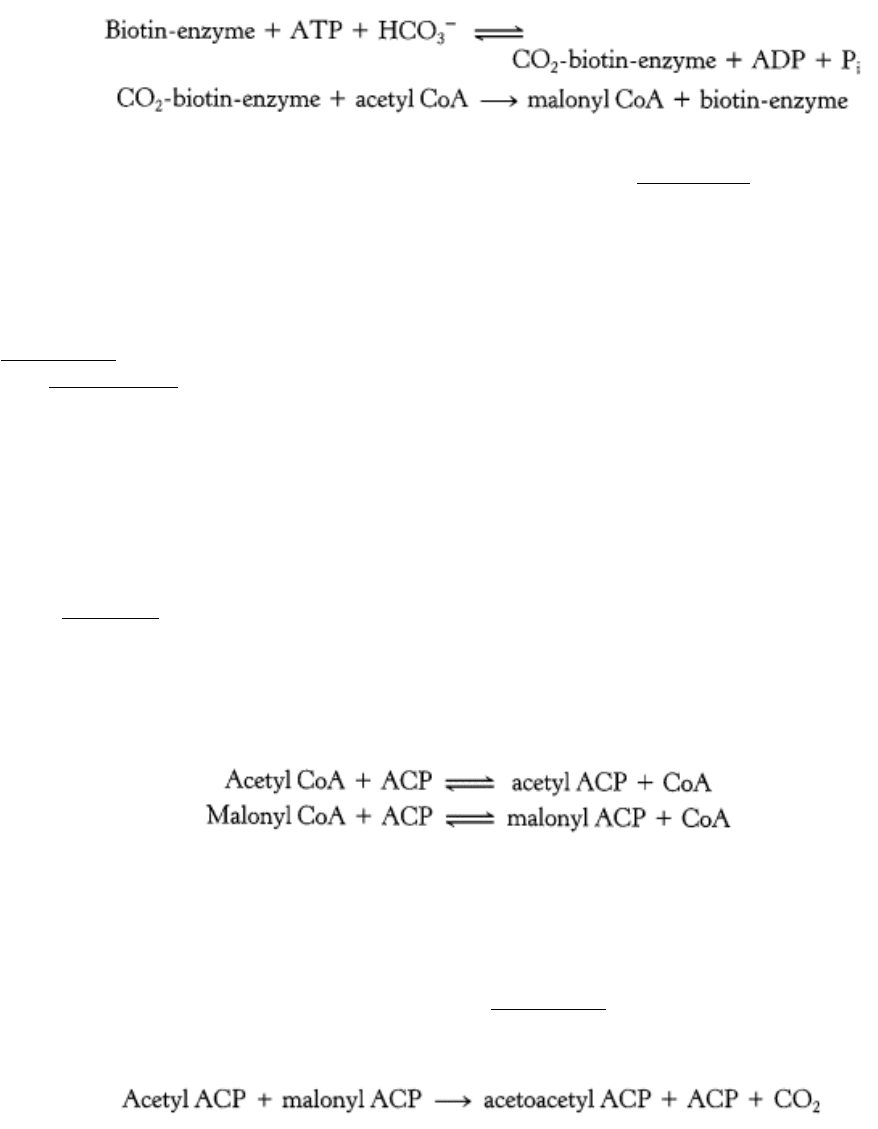
This enzyme is also the essential regulatory enzyme for fatty acid metabolism (Section 22.5).
22.4.2. Intermediates in Fatty Acid Synthesis Are Attached to an Acyl Carrier Protein
The intermediates in fatty acid synthesis are linked to an acyl carrier protein. Specifically, they are linked to the
sulfhydryl terminus of a phosphopantetheine group, which is, in turn, attached to a serine residue of the acyl carrier
protein (Figure 22.21). Recall that, in the degradation of fatty acids, a phosphopantetheine group is present as part of
CoA instead (Section 22.2.2). ACP, a single polypeptide chain of 77 residues, can be regarded as a giant prosthetic
group, a "macro CoA."
22.4.3. The Elongation Cycle in Fatty Acid Synthesis
The enzyme system that catalyzes the synthesis of saturated long-chain fatty acids from acetyl CoA, malonyl CoA, and
NADPH is called the fatty acid synthase. The constituent enzymes of bacterial fatty acid synthases are dissociated when
the cells are broken apart. The availability of these isolated enzymes has facilitated the elucidation of the steps in fatty
acid synthesis (Table 22.2). In fact, the reactions leading to fatty acid synthesis in higher organisms are very much like
those of bacteria.
The elongation phase of fatty acid synthesis starts with the formation of acetyl ACP and malonyl ACP. Acetyl
transacylase and malonyl transacylase catalyze these reactions.
Malonyl transacylase is highly specific, whereas acetyl transacylase can transfer acyl groups other than the acetyl unit,
though at a much slower rate. Fatty acids with an odd number of carbon atoms are synthesized starting with propionyl
ACP, which is formed from propionyl CoA by acetyl transacylase.
Acetyl ACP and malonyl ACP react to form acetoacetyl ACP (Figure 22.22). The acyl-malonyl ACP condensing enzyme
catalyzes this condensation reaction.
In the condensation reaction, a four-carbon unit is formed from a twocarbon unit and a three-carbon unit, and CO
2
is
released. Why is the four-carbon unit not formed from 2 two-carbon units? In other words, why are the reactants acetyl
ACP and malonyl ACP rather than two molecules of acetyl ACP? The answer is that the equilibrium for the synthesis of
acetoacetyl ACP from two molecules of acetyl ACP is highly unfavorable. In contrast, the equilibrium is favorable if
malonyl ACP is a reactant because its decarboxylation contributes a substantial decrease in free energy. In effect, ATP
drives the condensation reaction, though ATP does not directly participate in the condensation reaction. Rather, ATP is
used to carboxylate acetyl CoA to malonyl CoA. The free energy thus stored in malonyl CoA is released in the
decarboxylation accompanying the formation of acetoacetyl ACP. Although HCO
3
-
is required for fatty acid synthesis,
its carbon atom does not appear in the product. Rather, all the carbon atoms of fatty acids containing an even number of
carbon atoms are derived from acetyl CoA.

The next three steps in fatty acid synthesis reduce the keto group at C-3 to a methylene group (see Figure 22.22). First,
acetoacetyl ACP is reduced to d-3-hydroxybutyryl ACP. This reaction differs from the corresponding one in fatty acid
degradation in two respects: (1) the d rather than the l isomer is formed; and (2) NADPH is the reducing agent, whereas
NAD
+
is the oxidizing agent in β oxidation. This difference exemplifies the general principle that NADPH is consumed
in biosynthetic reactions, whereas NADH is generated in energy-yielding reactions. Then d-3-hydroxybutyryl ACP is
dehydrated to form crotonyl ACP, which is a trans-∆
2
-enoyl ACP. The final step in the cycle reduces crotonyl ACP to
butyryl ACP. NADPH is again the reductant, whereas FAD is the oxidant in the corresponding reaction in β-oxidation.
The enzyme that catalyzes this step, enoyl ACP reductase, is inhibited by triclosan, a broad-spectrum antibacterial agent.
Triclosan is used in a variety of products such as toothpaste, soaps, and skin creams. These last three reactions
a
reduction, a dehydration, and a second reduction convert acetoacetyl ACP into butyryl ACP, which completes the first
elongation cycle.
In the second round of fatty acid synthesis, butyryl ACP condenses with malonyl ACP to form a C
6
-β-ketoacyl ACP.
This reaction is like the one in the first round, in which acetyl ACP condenses with malonyl ACP to form a C
4
-β-
ketoacyl ACP. Reduction, dehydration, and a second reduction convert the C
6
-β-ketoacyl ACP into a C
6
-acyl ACP,
which is ready for a third round of elongation. The elongation cycles continue until C
16
-acyl ACP is formed. This
intermediate is a good substrate for a thioesterase that hydrolyzes C
16
-acyl ACP to yield palmitate and ACP. The
thioesterase acts as a ruler to determine fatty acid chain length. The synthesis of longer-chain fatty acids is discussed in
Section 22.6.
22.4.4. Fatty Acids Are Synthesized by a Multifunctional Enzyme Complex in
Eukaryotes
Although the basic biochemical reactions in fatty acid synthesis are very similar in E. coli and eukaryotes, the structure
of the synthase varies considerably. The fatty acid synthases of eukaryotes, in contrast with those of E. coli, have the
component enzymes linked in a large polypeptide chain.
Mammalian fatty acid synthase is a dimer of identical 260-kd subunits. Each chain is folded into three domains joined by
flexible regions (Figure 22.23). Domain 1, the substrate entry and condensation unit, contains acetyl transferase,
malonyl transferase, and β-ketoacyl synthase (condensing enzyme). Domain 2, the reduction unit, contains the acyl
carrier protein, β-ketoacyl reductase, dehydratase, and enoyl reductase. Domain 3, the palmitate release unit, contains
the thioesterase. Thus, seven different catalytic sites are present on a single polypeptide chain. It is noteworthy that
many eukaryotic multienzyme complexes are multifunctional proteins in which different enzymes are linked covalently.
An advantage of this arrangement is that the synthetic activity of different enzymes is coordinated. In addition, a
multienzyme complex consisting of covalently joined enzymes is more stable than one formed by noncovalent
attractions. Furthermore, intermediates can be efficiently handed from one active site to another without leaving the
assembly. It seems likely that multifunctional enzymes such as fatty acid synthase arose in eukaryotic evolution by exon
shuffling (Section 5.6.2), because each of the component enzymes is recognizably homologous to its bacterial
counterpart.
22.4.5. The Flexible Phosphopantetheinyl Unit of ACP Carries Substrate from One
Active Site to Another
We next examine the coordinated functioning of the mammalian fatty acid synthase. Fatty acid synthesis begins with the
transfer of the acetyl group of acetyl CoA first to a serine residue in the active site of acetyl transferase and then to the
sulfur atom of a cysteine residue in the active site of the condensing enzyme on one chain of the dimeric enzyme.
Similarly, the malonyl group is transferred from malonyl CoA first to a serine residue in the active site of malonyl
transferase and then to the sulfur atom of the phosphopantetheinyl group of the acyl carrier protein on the other chain in
the dimer. Domain 1 of each chain of this dimer interacts with domains 2 and 3 of the other chain. Thus, each of the two
functional units of the synthase consists of domains formed by different chains. Indeed, the arenas of catalytic action are

the interfaces between domains on opposite chains.
Elongation begins with the joining of the acetyl unit on the condensing enzyme (CE) to a two-carbon part of the malonyl
unit on ACP (Figure 22.24).
CO
2
is released and an acetoacetyl-S-phosphopantetheinyl unit is formed on ACP. The active-site sulfhydryl group on
the condensing enzyme is restored. The acetoacetyl group is then delivered to three active sites in domain 2 of the
opposite chain to reduce it to a butyryl unit. This saturated C
4
unit then migrates from the phosphopantetheinyl sulfur
atom on ACP to the cysteine sulfur atom on the condensing enzyme. The synthase is now ready for another round of
elongation. The butyryl unit on the condensing enzyme becomes linked to a two-carbon part of the malonyl unit on ACP
to form a six-carbon unit on ACP, which undergoes reduction. Five more rounds of condensation and reduction produce
a palmitoyl (C
16
) chain on the condensing enzyme, which is hydrolyzed to palmitate by the thioesterase on domain 3 of
the opposite chain. The migration of the growing fatty acyl chain back and forth between ACP and the condensing
enzyme in each round of elongation is analogous to the translocations of growing peptide chains that take place in
protein synthesis (Section 29.3.7).
The flexibility and 20-Å maximal length of the phosphopantetheinyl moiety are critical for the function of this
multienzyme complex. The enzyme subunits need not undergo large structural rearrangements to interact with the
substrate. Instead, the substrate is on a long, flexible arm that can reach each of the numerous active sites. Recall that
biotin and lipoamide also are on long, flexible arms in their multienzyme complexes. The organization of the fatty acid
synthases of higher organisms enhances the efficiency of the overall process because intermediates are directly
transferred from one active site to the next.
22.4.6. The Stoichiometry of Fatty Acid Synthesis
The stoichiometry of the synthesis of palmitate is
The equation for the synthesis of the malonyl CoA used in the preceding reaction is
Hence, the overall stoichiometry for the synthesis of palmitate is
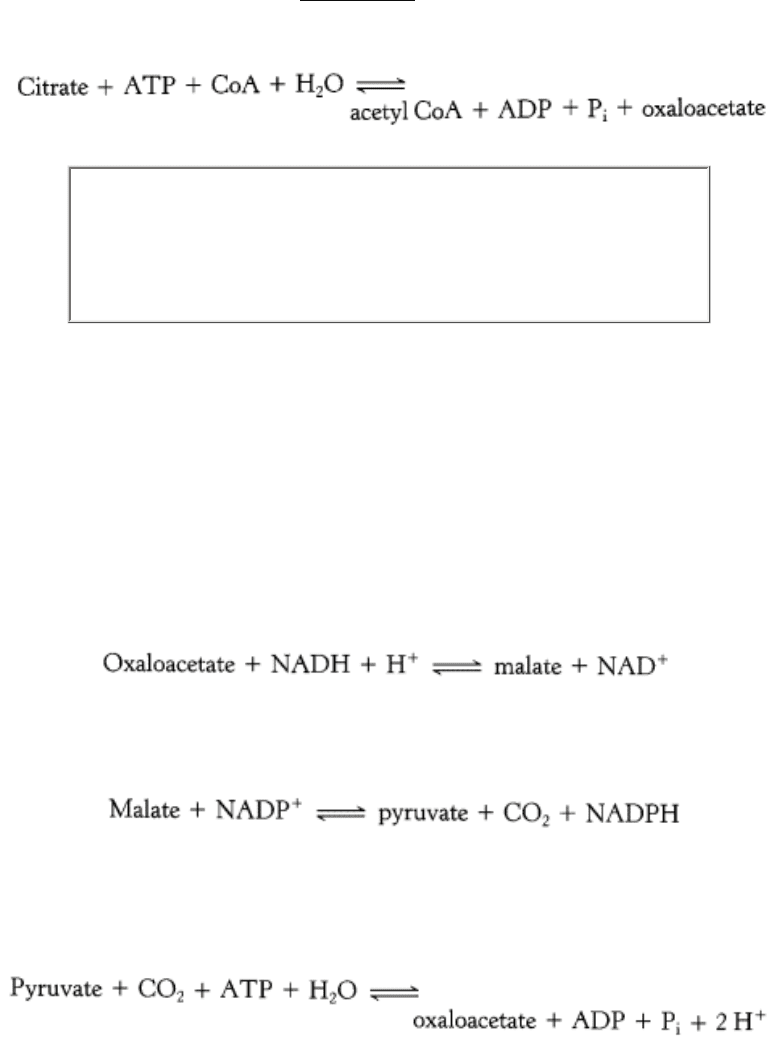
22.4.7. Citrate Carries Acetyl Groups from Mitochondria to the Cytosol for Fatty Acid
Synthesis
The synthesis of palmitate requires the input of 8 molecules of acetyl CoA, 14 molecules of NADPH, and 7 molecules of
ATP. Fatty acids are synthesized in the cytosol, whereas acetyl CoA is formed from pyruvate in mitochondria. Hence,
acetyl CoA must be transferred from mitochondria to the cytosol. Mitochondria, however, are not readily permeable to
acetyl CoA. Recall that carnitine carries only long-chain fatty acids. The barrier to acetyl CoA is bypassed by citrate,
which carries acetyl groups across the inner mitochondrial membrane. Citrate is formed in the mitochondrial matrix by
the condensation of acetyl CoA with oxaloacetate (Figure 22.25). When present at high levels, citrate is transported to
the cytosol, where it is cleaved by ATP-citrate lyase.
Lyases-
Enzymes catalyzing the cleavage of C-C, C-O, or C-N bonds by
elimination. A double bond is formed in these reactions.
Thus, acetyl CoA and oxaloacetate are transferred from mitochondria to the cytosol at the expense of the hydrolysis of a
molecule of ATP.
22.4.8. Sources of NADPH for Fatty Acid Synthesis
Oxaloacetate formed in the transfer of acetyl groups to the cytosol must now be returned to the mitochondria. The inner
mitochondrial membrane is impermeable to oxaloacetate. Hence, a series of bypass reactions are needed. Most
important, these reactions generate much of the NADPH needed for fatty acid synthesis. First, oxaloacetate is reduced to
malate by NADH. This reaction is catalyzed by a malate dehydrogenase in the cytosol.
Second, malate is oxidatively decarboxylated by an NADP
+
-linked malate enzyme (also called malic enzyme).
The pyruvate formed in this reaction readily enters mitochondria, where it is carboxylated to oxaloacetate by pyruvate
carboxylase.
The sum of these three reactions is
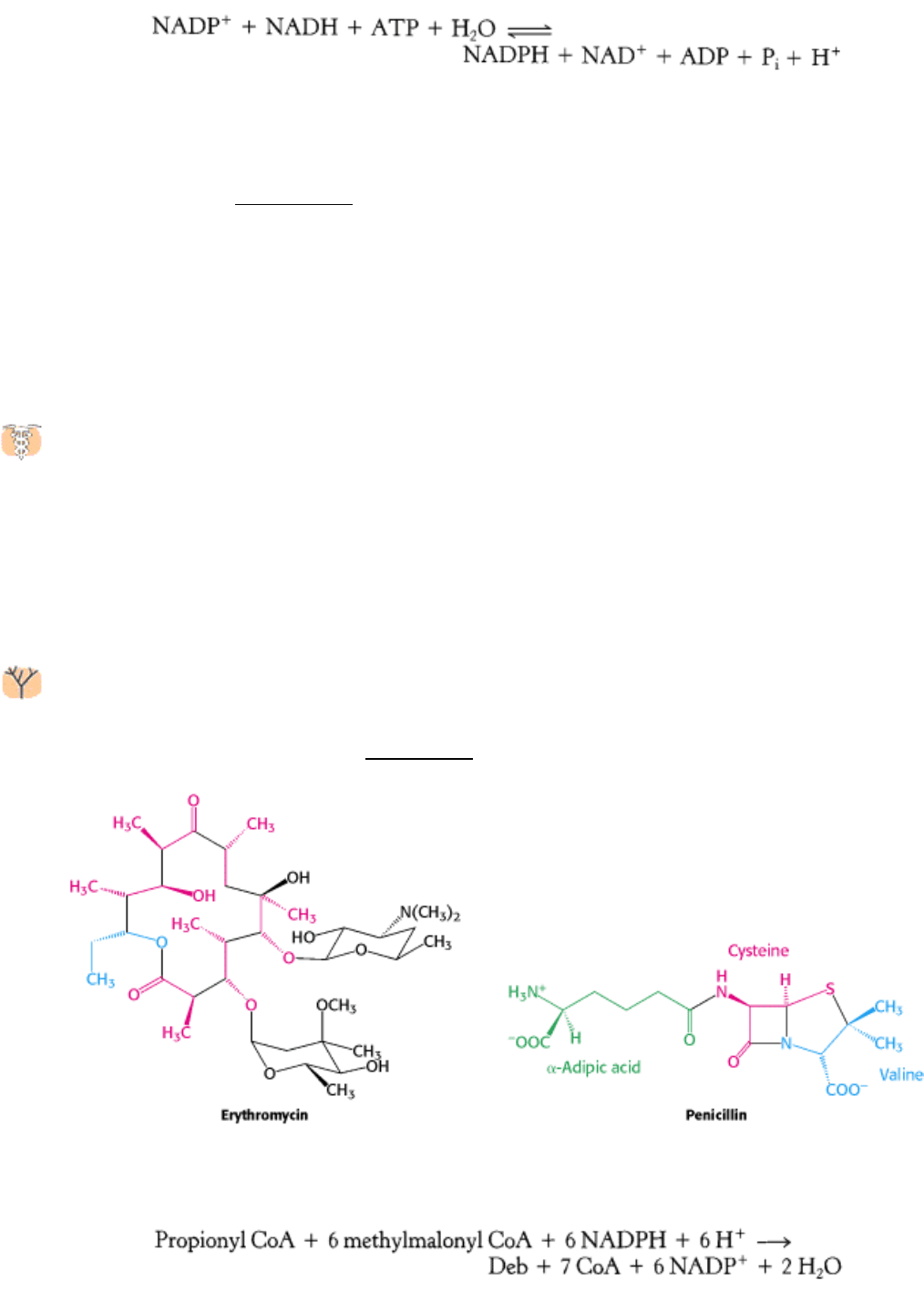
Thus, one molecule of NADPH is generated for each molecule of acetyl CoA that is transferred from mitochondria to the
cytosol. Hence, eight molecules of NADPH are formed when eight molecules of acetyl CoA are transferred to the
cytosol for the synthesis of palmitate. The additional six molecules of NADPH required for this process come from the
pentose phosphate pathway (Section 20.3.1).
The accumulation of the precursors for fatty acid synthesis is a wonderful example of the coordinated use of multiple
processes to fulfill a biochemical need. The citric acid cycle, subcellular compartmentalization, and the pentose
phosphate pathway provide the carbon atoms and reducing power, whereas glycolysis and oxidative phosphorylation
provide the ATP to meet the needs for fatty acid synthesis.
22.4.9. Fatty Acid Synthase Inhibitors May Be Useful Drugs
Fatty acid synthase is overexpressed in some breast cancers. Researchers intrigued by this observation have tested
inhibitors of fatty acid synthase on mice to see how the inhibitors affect tumor growth. A startling observation was
made: mice treated with inhibitors of the condensing enzyme showed remarkable weight loss due to inhibition of feeding.
The results of additional studies revealed that this inhibition is due, at least in part, to the accumulation of malonyl CoA.
Thus, fatty acid synthase inhibitors are exciting candidates both as antitumor and as antiobesity drugs.
22.4.10. Variations on a Theme: Polyketide and Nonribosomal Peptide Synthetases
Resemble Fatty Acid Synthase
The mammalian multifunctional fatty acid synthase is a member of a large family of complex enzymes termed
megasynthases that participate in step-by-step synthetic pathways. Two important classes of compounds that are
synthesized by such enzymes are the polyketides and the nonribosomal peptides. The antibiotic erythromycin is an
example of a polyketide, whereas penicillin (Section 8.5.5) is a nonribosomal peptide.
The core of erythromycin (deoxyerythronolide B, or Deb) is synthesized by the following reaction:
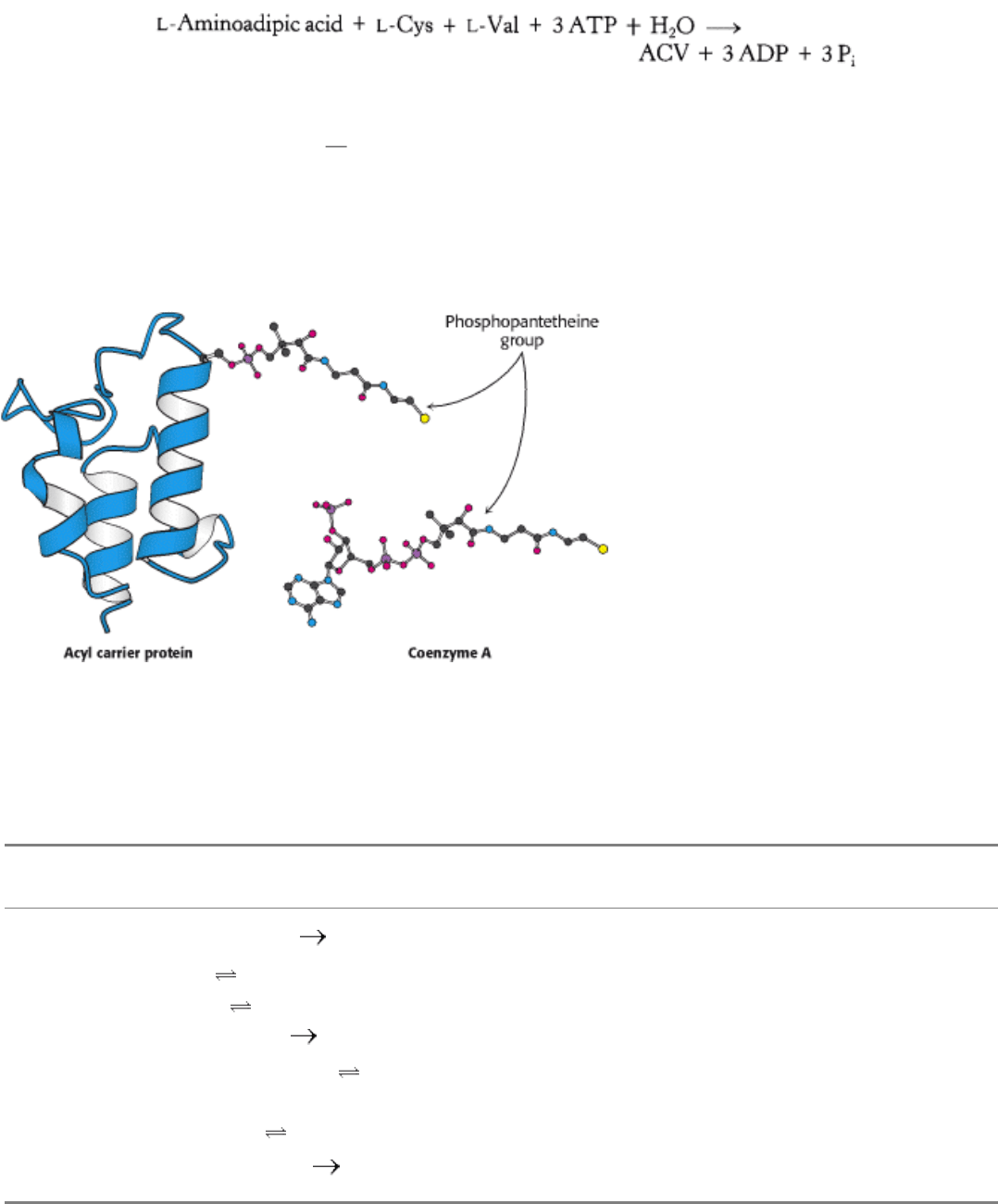
This reaction is accomplished by three megasynthases consisting of 3491, 3567, and 3172 amino acids. The synthesis of
deoxyerythronolide B begins with propionyl CoA linked to a phosphopantetheine chain connected to an acyl carrier
protein domain. Similarly, the precursor of penicillin [∆-(
l-aminoadipyl)-l-cysteinyl-d-valine, or ACV] is generated by
the following reaction:
which is catalyzed by a megasynthase consisting of 3791 amino acids. Each amino acid is activated by a specific
adenylation domain within the enzyme
a domain that is homologous to acyl CoA synthase. Additional domains are
responsible for peptide-bond formation and for the epimerization of the valine residue. Again, during synthesis, the
components are linked to phosphopantetheine chains. Members of this remarkably modular enzyme family generate
many of the natural products that have proved to be useful as drugs.
II. Transducing and Storing Energy 22. Fatty Acid Metabolism 22.4. Fatty Acids Are Synthesized and Degraded by Different Pathways
Figure 22.21. Phosphopantetheine. Both acyl carrier protein and CoA include phosphopantetheine as their reactive
units.
II. Transducing and Storing Energy 22. Fatty Acid Metabolism 22.4. Fatty Acids Are Synthesized and Degraded by Different Pathways
Table 22.2. Principal reactions in fatty acid synthesis in bacteria
Step Reaction Enzyme
1
Acetyl CoA + HCO
3
-
+ ATP malonyl CoA + ADP + P
i
+ H
+
Acetyl CoA carboxylase
2 Acetyl CoA + ACP
acetyl ACP + CoA Acetyl transacylase
3 Malonyl CoA + ACP
malonyl ACP + CoA Malonyl transacylase
4 Acetyl ACP + malonyl ACP
acetoacetyl ACP + ACP + CO
2
Acyl-malonyl ACP condensing enzyme
5
Acetoacetyl ACP + NADPH + H
+
d-3-hydroxybutyryl ACP + NADP
+
β-Ketoacyl ACP reductase
6
d-3-Hydroxybutyryl ACP crotonyl ACP + H
2
O 3-Hydroxyacyl ACP dehydratase
7
Crotonyl ACP + NADPH + H
+
butyryl ACP + NADP
+
Enoyl ACP reductase

II. Transducing and Storing Energy 22. Fatty Acid Metabolism 22.4. Fatty Acids Are Synthesized and Degraded by Different Pathways
Figure 22.22. Fatty Acid Synthesis. Fatty acids are synthesized by the repetition of the following reaction sequence:
condensation, reduction, dehydration, and reduction. The intermediates shown here are produced in the first round of
synthesis.
II. Transducing and Storing Energy 22. Fatty Acid Metabolism 22.4. Fatty Acids Are Synthesized and Degraded by Different Pathways

Figure 22.23. Schematic Representation of Animal Fatty Acid Synthase. Each of the identical chains in the dimer
contains three domains. Domain 1 (blue) contains acetyl transferase (AT), malonyl transferase (MT), and condensing
enzyme (CE). Domain 2 (yellow) contains acyl carrier protein (ACP), β-ketoacyl reductase (KR), dehydratase (DH), and
enoyl reductase (ER). Domain 3 (red) contains thioesterase (TE). The flexible phosphopantetheinyl group (green) carries
the fatty acyl chain from one catalytic site on a chain to another, as well as between chains in the dimer. [After Y.
Tsukamoto, H. Wong, J. S. Mattick, and S. J. Wakil. J. Biol. Chem. 258(1983):15312.]
II. Transducing and Storing Energy 22. Fatty Acid Metabolism 22.4. Fatty Acids Are Synthesized and Degraded by Different Pathways
Figure 22.24. Reactions of Fatty Acid Synthase. Translocations of the elongating fatty acyl chain between the cysteine
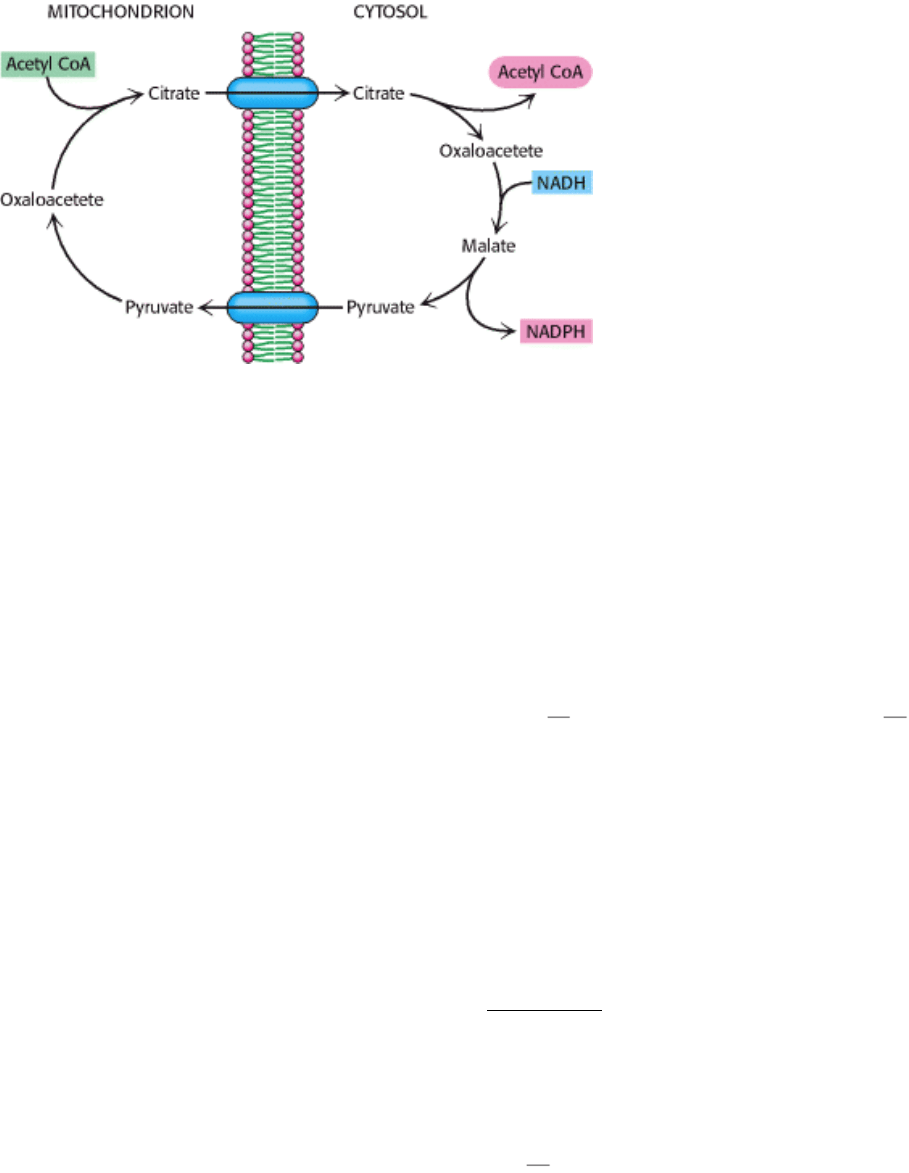
sulfhydryl group of the condensing enzyme (CE, blue) and the phosphopantetheine sulfhydryl group of the acyl carrier
protein (ACP, yellow) lead to the growth of the fatty acid chain. The reactions are repeated until the palmitoyl product is
synthesized.
II. Transducing and Storing Energy 22. Fatty Acid Metabolism 22.4. Fatty Acids Are Synthesized and Degraded by Different Pathways
Figure 22.25. Transfer of Acetyl CoA to the Cytosol. Acetyl CoA is transferred from mitochondria to the cytosol, and
the reducing potential NADH is concomitantly converted into that of NADPH by this series of reactions.
II. Transducing and Storing Energy 22. Fatty Acid Metabolism
22.5. Acetyl Coenzyme A Carboxylase Plays a Key Role in Controlling Fatty Acid
Metabolism
Fatty acid metabolism is stringently controlled so that synthesis and degradation are highly responsive to physiological
needs. Fatty acid synthesis is maximal when carbohydrate and energy are plentiful and when fatty acids are scarce.
Acetyl CoA carboxylase plays an essential role in regulating fatty acid synthesis and degradation. Recall that this
enzyme catalyzes the committed step in fatty acid synthesis: the production of malonyl CoA (the activated two-carbon
donor). The carboxylase is controlled by three global signals
glucagon, epinephrine, and insulin that correspond to
the overall energy status of the organism. Insulin stimulates fatty acid synthesis by activating the carboxylase, whereas
glucagon and epinephrine have the reverse effect. The levels of citrate, palmitoyl CoA, and AMP within a cell also exert
control. Citrate, a signal that building blocks and energy are abundant, activates the carboxylase. Palmitoyl CoA and
AMP, in contrast, lead to the inhibition of the carboxylase. Thus, this important enzyme is subject to both global and
local regulation. We will examine each of these levels of regulation in turn.
Global Regulation.
Global regulation is carried out by means of reversible phosphorylation. Acetyl CoA carboxylase is switched off by
phosphorylation and activated by dephosphorylation (Figure 22.26). Modification of a single serine residue by an AMP-
dependent protein kinase (AMPK) converts the carboxylase into an inactive form. The phosphoryl group on the inhibited
carboxylase is removed by protein phosphatase 2A. The proportion of carboxylase in the active dephosphorylated form
depends on the relative rates of these opposing enzymes.
How is the formation of the inactive, phosphorylated form of the enzyme regulated? AMPK, the enzyme that
phosphorylates the carboxylase, is essentially a fuel gauge
it is activated by AMP and inhibited by ATP. Thus, the
carboxylase is inactivated when the energy charge is low. This kinase is conserved among eukaryotes. Homologs found
in yeast and plants also play roles in sensing the energy status of the cell. The inhibition of phosphatase 2A is necessary
to maintain acetyl CoA carboxylase in the phosphorylated state. Epinephrine and glucagon activate protein kinase A,
which in turn inhibits the phosphatase by phosphorylating it. Hence, these catabolic hormones switch off fatty acid
synthesis by keeping the carboxylase in the inactive phosphorylated state.

How is the enzyme dephosphorylated and activated? Insulin stimulates the carboxylase by causing its
dephosphorylation. It is not clear which of the phosphatases activates the carboxylase in response to insulin. The
hormonal control of acetyl CoA carboxylase is reminiscent of that of glycogen synthase (Section 21.5.2).
Local Regulation.
Acetyl CoA carboxylase is also under local control. This enzyme is allosterically stimulated by citrate. Specifically,
citrate partly reverses the inhibition produced by phosphorylation. It acts in an unusual manner on inactive acetyl CoA
carboxylase, which exists as an octamer (Figure 22.27). Citrate facilitates the polymerization of the inactive octamers
into active filaments (Figure 22.28). The level of citrate is high when both acetyl CoA and ATP are abundant. Recall that
mammalian isocitrate dehydrogenase is inhibited by a high energy charge (Section 17.2.2). Hence, a high level of citrate
signifies that two-carbon units and ATP are available for fatty acid synthesis. The stimulatory effect of citrate on the
carboxylase is antagonized by palmitoyl CoA, which is abundant when there is an excess of fatty acids. Palmitoyl CoA
causes the filaments to disassemble into the inactive octamers. Palmitoyl CoA also inhibits the translocase that transports
citrate from mitochondria to the cytosol, as well as glucose 6-phosphate dehydrogenase, which generates NADPH in the
pentose phosphate pathway.
Response to Diet.
Fatty acid synthesis and degradation are reciprocally regulated so that both are not simultaneously active. In starvation,
the level of free fatty acids rises because hormones such as epinephrine and glucagon stimulate adipose-cell lipase.
Insulin, in contrast, inhibits lipolysis. Acetyl CoA carboxylase also plays a role in the regulation of fatty acid
degradation. Malonyl CoA, the product of the carboxylase reaction, is present at a high level when fuel molecules are
abundant. Malonyl CoA inhibits carnitine acyltransferase I, preventing access of fatty acyl CoAs to the mitochondrial
matrix in times of plenty. Malonyl CoA is an especially effective inhibitor of carnitine acyltransferase I in heart and
muscle, tissues that have little fatty acid synthesis capacity of their own. In these tissues, acetyl CoA carboxylase may be
a purely regulatory enzyme. Finally, two enzymes in the β-oxidation pathway are markedly inhibited when the energy
charge is high. NADH inhibits 3-hydroxyacyl CoA dehydrogenase, and acetyl CoA inhibits thiolase.
Long-term control is mediated by changes in the rates of synthesis and degradation of the enzymes participating in fatty
acid synthesis. Animals that have fasted and are then fed high-carbohydrate, low-fat diets show marked increases in their
amounts of acetyl CoA carboxylase and fatty acid synthase within a few days. This type of regulation is known as
adaptive control.
II. Transducing and Storing Energy 22. Fatty Acid Metabolism 22.5. Acetyl Coenzyme A Carboxylase Plays a Key Role in Controlling Fatty Acid Metabolism
Figure 22.26. Control of Acetyl CoA Carboxylase. Acetyl CoA carboxylase is inhibited by phosphorylation and
activated by the binding of citrate.
